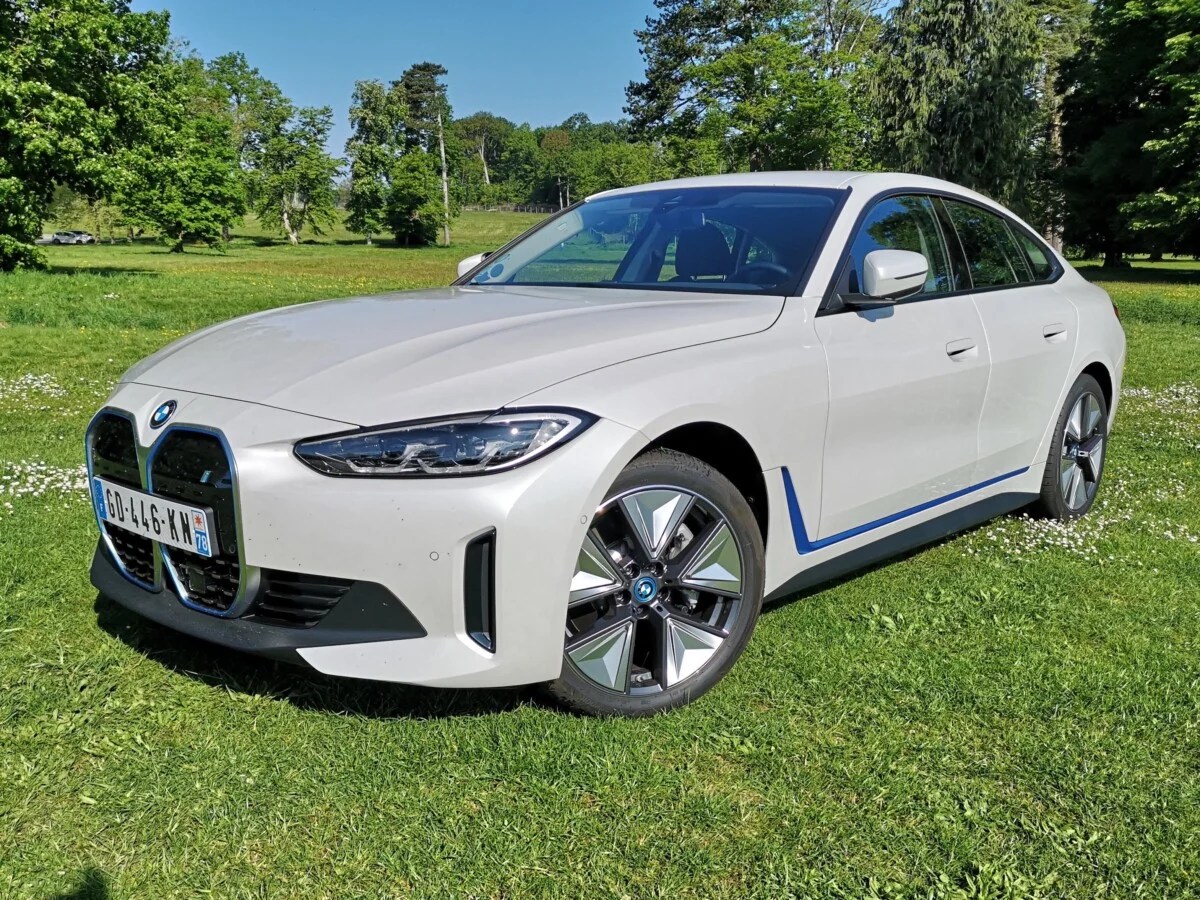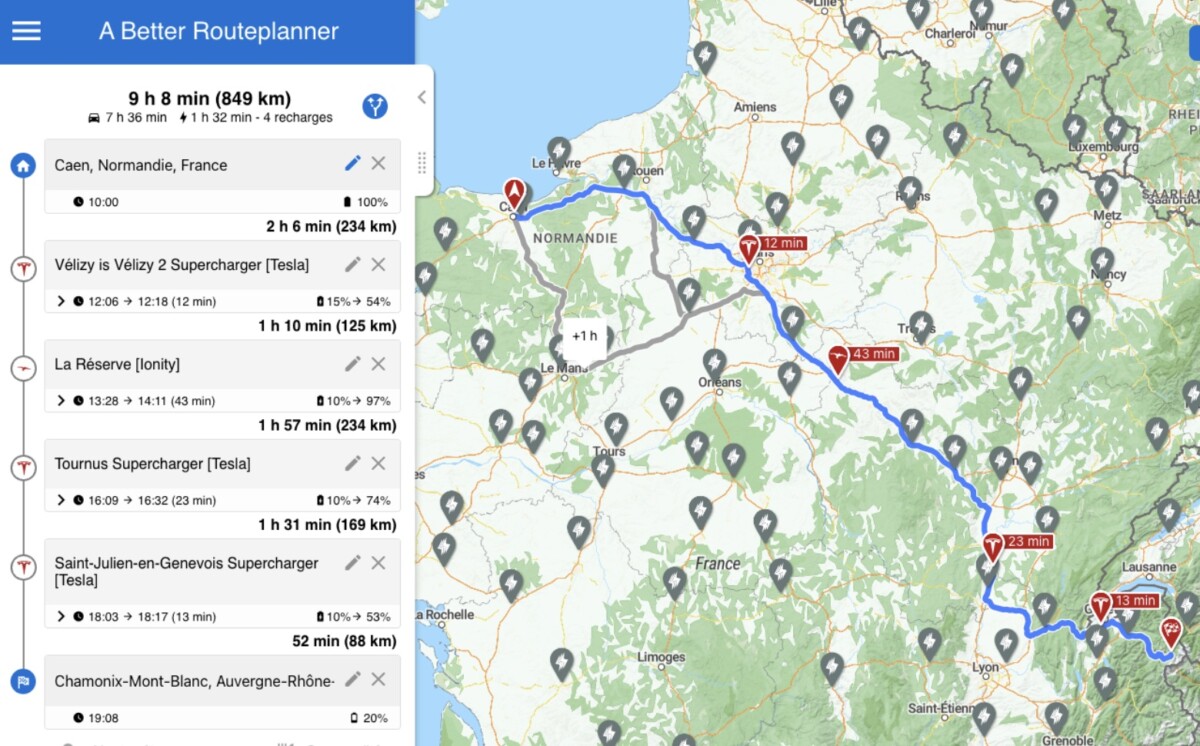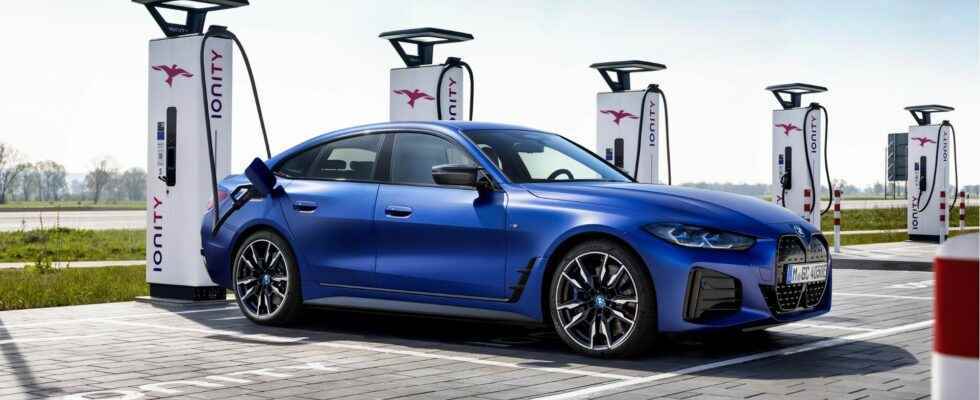The latest electric sedan from the Bavarian group is in the spotlight today in the exercise of long holiday journeys. It will be compared to the other electric cars already reviewed, in order to determine which is the most likely to offer a hassle-free experience So, how are the long journeys in the BMW i4 going?
After having exposed the cases of the Tesla Model 3 Propulsion, Kia EV6 58 kWh, Tesla Model 3 Grande Autonomie and Hyundai Ioniq 5, it is the turn of the BMW i4 to be examined in detail in a dreaded exercise of electric cars: the long journeys.
A brief reminder of the rules of the exercise for all practical purposes: the start is at 100% battery, the finish at 20% and the vehicle must be driven at the limit speeds. We will first go back to the characteristics of the vehicle (range, battery, charging power) to better compare them with the reality on the ground.
Thus, in particular by consulting our summary table below, you will have all the cards in hand to find the electric car that will bring you the fewest possible constraints on long trips. Let’s take a look at how long journeys in the BMW i4 are like.
The characteristics of the BMW i4
The BMW i4 has a battery of approximately 81 useful kWh, which makes it a vehicle of choice for long trips. Indeed, with an announced autonomy in the WLTP cycle of 590 kilometers, it is found at the level of electric cars of the moment offering the greatest radius of action.
In addition, its peak charging power is 210 kW, which allows it to go from 10 to 80% battery in 31 minutes in ideal conditions. During this simulation, we will use the different fast charging networks available in France depending on what is most appropriate between Ionity, Totalenergies, Fastned and the Tesla Superchargers open to all.

We will see if the current state of the charging infrastructure is sufficient for our reference routes to be a formality, or if, on the contrary, we must be careful not to risk running out of fuel. As always, we rely on the benchmark for electric car trip planning, A Better Route Planner, with the default consumption benchmark for the BMW i4.
Route planning
Given that we start trips at 100% battery, you have to pay for this filling before the big departure. We consider that fully charging the BMW i4 at the average price per kWh in France amounts to 0.17 euro today. The approximately 81 kWh of the battery pack then represent €13.80. We will take this cost into account when taking stock of each major journey.
Our reference journeys are intended to simulate summer holidays on the one hand, between Orléans and Arcachon (530 kilometres), and a long winter journey between Caen and Chamonix-Mont-Blanc on the other hand (850 kilometres).
In order to stick as closely as possible to reality, the parameters indicated in A Better Route Planner are the following for the summer: 25 degrees Celsius outside temperature, no wind, arrival at a charging station with 10% battery remaining, and arrival at destination at 20%. For the winter trip, it’s essentially the same, apart from the weather, where we chose a temperature of 0 degrees Celsius.
We will thus have a good overview of the impact of the outside temperature and the elevation gain on consumption.
The balance sheet of the different routes
A single stop to cover more than 500 kilometers
On this journey between Orléans and Arcachon, the BMW i4 keeps its promises rather well, in the sense that it only takes one stop to recharge to arrive at its destination with 20% battery. All it takes is a 37-minute charge at the Ionity aire station in Poitou-Charentes, for a total cost of 44 euros, and that’s it. This charge went from 14% to 93% battery, which makes it a very big charge.
The expected consumption would amount to 211 Wh/km while driving at the speed limits, which is very correct. An alternative route is possible, saving a few euros at the expense of a few more minutes on the road.

It would thus be a question of leaving the motorway at the level of the south of Poitiers to join Bordeaux via Angoulême, which would force to load twice, but much less time. Indeed, after an ultra-fast 6-minute charge at Ionity north of Poitiers to go from 39 to 56% battery (9.50 euros), head for the Tesla Supercharger in Angoulême.
120 kilometers further, a charge of 17 minutes (25 euros) to recharge from 24 to 69% is sufficient to arrive at your destination with 20% battery. For this trip, the announced consumption is 195 Wh/km, around 8% better than on the other trip, exclusively on the motorway.
The gain is all the same ten euros for having lost only six minutes in theory, which is all in all very acceptable. It will therefore be necessary to choose whether you want a single stop, even if it means paying more, or whether two (shorter) stops when leaving the motorway are preferable for you.
With the two possible choices and adding the cost of the initial home charge, this summer trip in a BMW i4 costs between 48 and 58 euroswith a charging time of 22 minutes (two stops) or 37 minutes (one stop).
850 kilometers without incident, thanks to Tesla Superchargers
For a vehicle with an advertised range of nearly 600 kilometres, the real challenge begins with long journeys exceeding this symbolic bar. For the BMW i4, our winter trip is therefore going to be a perfect test. We will see that she is doing rather with honors.
Leaving 100% from Caen, the first stop is made some 235 kilometers further, at the Tesla Supercharger in Vélizy. It only takes 12 minutes to go from 12 to 54% (24 euros), before heading towards the Aire de la Réserve which has the longest break in store for us. It takes no less than 43 minutes and an almost full charge (10 to 97%) on an Ionity charger, for 49 euros, to be able to continue serenely.

The last two stops are at Tesla Superchargers open to all, which have a major advantage over the competition: their number of available terminals. Indeed, whether at the Supercharger in Tournus or Saint-Julien-en-Genevois, the last two stops on this journey, no less than twenty charging stations are available. There is therefore no need to worry about the availability of a charging point, which remains one of the weak points of Ionity in particular.
At these two places, it takes respectively a charge of 23 minutes in Tournus (36 euros) and 13 minutes in Saint-Julien-en-Genevois (24 euros) to arrive in Chamonix with 20% of battery remaining. the total travel time is therefore 9 hours and 8 minutesincluding a 1 hour and 32 minute charge time. Including the cost of home charging, the bill is 147 euros. The estimated average consumption reaches 257 Wh/km, which would give a range of 315 kilometers in winter conditions on the highway.
Consumption, cost of recharging and range
We summarize the costs and charging times (including home charging at 13.80 euros) in the table below. You can thus visualize as we go through our examples where the vehicle you are interested in is positioned in relation to the others on a similar journey.
| Vehicle | Summer ride cost | Summer ride charging time | Total summer journey time |
|---|---|---|---|
| Tesla Model 3 Drive | 36 – 49 € | 31 mins | 5 h 09 min |
| Tesla Model 3 Long Autonomy | 31 – 45 € | 13 – 25 mins | 4 hrs 56 mins |
| Kia EV6 58kWh | 52 – 60 € | 38 – 43 mins | 5 hrs 30 mins |
| BMW i4 | 48 – 58 € | 22 – 37 mins | 5 hrs 11 mins |
| Hyundai Ioniq 5 | 72 € | 36 mins | 5 hrs 16 mins |
| Vehicle | Winter trip cost | Winter ride charging time | Total winter journey time |
|---|---|---|---|
| Tesla Model 3 Drive | 102 € | 1 hr 42 mins | 9:16 a.m. |
| Tesla Model 3 Long Autonomy | 101.3 € | 1 hr 02 mins | 8:27 a.m. |
| Kia EV6 58kWh | 120 € | 1hr 54mins | 9 h 59 min |
| BMW i4 | 147 € | 1 hr 32 mins | 9 h 08 min |
| Hyundai Ioniq 5 | 145 € | 1hr 29mins | 9:14 a.m. |
Conclusion
Does the BMW i4 keep its promises on long journeys? In terms of journey time, we can see that it ranks very well in the rankings, both summer and winter. However, its biggest rival, the Tesla Model 3 Grande Autonomie, still comes out on top, especially in winter when 40 minutes more are needed for the BMW i4. This is explained by the lower consumption of the American, coupled with its faster recharging speed.
In summer, the time difference is insignificant as the vehicles are close together on a 500 kilometer journey, but the cost of the journey is not. Indeed, with a cost per 100 kilometers between 9 and 11 euros in summer for the BMW i4, it remains a little more expensive to drive than the Tesla Model 3 Grande Autonomie (between 6.8 and 9 euros per 100 kilometers). Compared to the Hyundai Ioniq 5 (13.60 euros per 100 kilometers), however, it does much better, while not charging longer.

In winter, we arrive at a price per 100 kilometers of 17.30 euros, the equivalent of a thermal car consuming approximately 8.5 liters per 100 kilometers. It’s not cheap, but it’s not overpriced either, thankfully. However, this is almost 50% more expensive than a Tesla Model 3 in the same financial year, and even a few euros more expensive than a Hyundai Ioniq 5.
Of course, long journeys such as those presented here remain exceptional journeys for the majority of drivers, and the cost per 100 kilometers all year round is closer to 3 euros. But it is clear that long electric trips are not necessarily financially attractive, as we can see with costs exceeding 15 euros per 100 kilometers on the motorway.
It is possible to optimize the costs exposed here in particular thanks to a Tesla subscription of 12.99 euros per month (without commitment), ensuring a 25% reduction for Superchargers. Ionity also offers a subscription at 17.99 euros per month for a reduced price, but the commitment being one year, it is necessary to drive a lot to cover its costs.
To follow us, we invite you to download our Android and iOS application. You can read our articles, files, and watch our latest YouTube videos.


